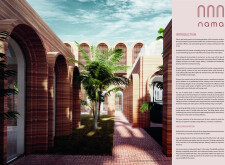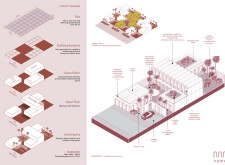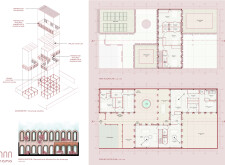5 key facts about this project
## Overview
The NAMA project is situated in Dubai and addresses the increasing demand for housing due to the city’s population growth. It focuses on modular housing solutions that emphasize sustainability, adaptability, and a contemporary interpretation of traditional architecture suited for family living. The design prominently features rammed earth, linking historical building practices with modern environmental considerations.
## Spatial Organization and Community Integration
The site is organized into a grid measuring 15 meters in width and 30 meters in length, divided into optimized 3-meter sections. This layout fosters spatial relationships between private living quarters and communal areas, enhancing both privacy and community engagement. The architectural footprint strategically separates private zones, such as bedrooms, from public spaces like living rooms and kitchens, ensuring functional clarity and promoting comfortable living.
Within the internal configuration, the ground floor contains the kitchen and living areas, which transition seamlessly into private outdoor spaces. The upper floor is designated for bedrooms, maintaining a clear distinction from communal areas. This arrangement reinforces the dual focus on individual privacy and community interaction, vital in urban environments.
## Materiality and Sustainability
NAMA employs several sustainable materials to enhance energy efficiency and minimize environmental impact. Rammed earth serves as a primary construction material, offering both thermal mass and aesthetic value while establishing a connection to local heritage. Prefabricated insulated rammed earth sandwich panels provide insulation and contribute to energy efficiency, supported by a reinforced concrete structure that ensures durability.
Incorporating solar panels further promotes energy independence, while landscaping designed with semi-private gardens and intensive green roofs enhances livability and ecological benefits. Innovative features, such as rainwater collection systems and adjustable window frames for natural ventilation, exemplify the project’s commitment to sustainable design practices.

























































